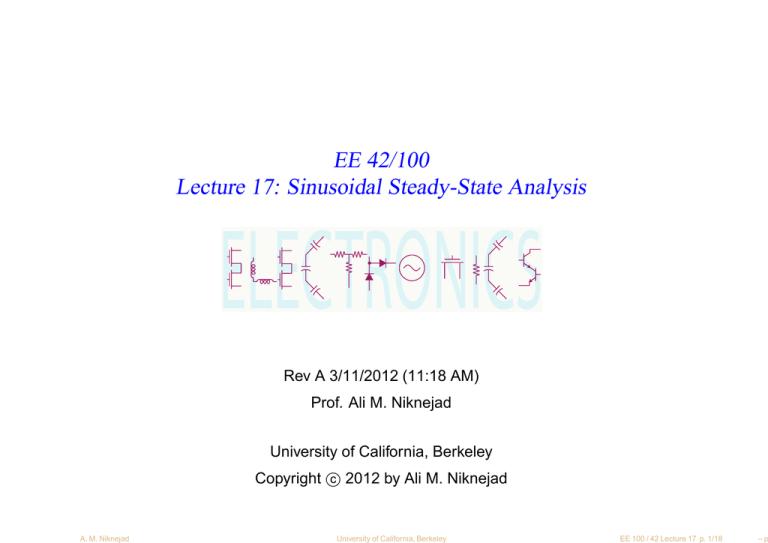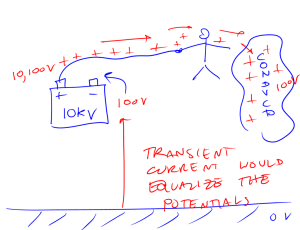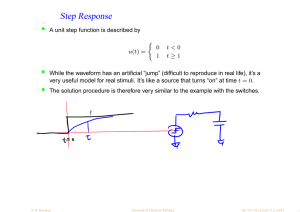Document 11094713
advertisement

EE 42/100 Lecture 17: Sinusoidal Steady-State Analysis ELECTRONICS Rev A 3/11/2012 (11:18 AM) Prof. Ali M. Niknejad University of California, Berkeley c 2012 by Ali M. Niknejad Copyright A. M. Niknejad University of California, Berkeley EE 100 / 42 Lecture 17 p. 1/18 –p Complex Transfer Function • Excite a system with an input (complex exponential) voltage (or current) x. Define the output voltage y (or current) to be any node voltage (branch current). For a complex exponential input, the “transfer function” from input to output is simply given by: y H= = x • „ « c c 1 2 b0 + b1 jω + b2 (jω)2 + · · · + + + ··· jω (jω)2 We can write this as a rational function by combining all the terms: n1 + n2 jω + n3 (jω)2 + · · · H(ω) = d1 + d2 jω + d3 (jω)2 + · · · • • H is appropriately enough called the transfer function. The transfer function is often written in terms of the complex frequency s (s − z1 )(s − z2 ) · · · (s − zN ) n1 + n2 s + n3 s 2 + · · · = H(s) = d1 + d2 s + d3 s2 + · · · (s − p1 )(s − p2 ) · · · (s − pM ) • The system is characterized by the roots of the numerator and denominator polynomials . The zeros of the numerator are known as the “zeros” of the transfer function. The zero’s of the denominator are known as the “poles” of the system. Why poles? Think about pole tents and what happens when the denominator goes to zero. A. M. Niknejad University of California, Berkeley EE 100 / 42 Lecture 17 p. 2/18 –p Impede the Currents! i(t) v(t) • + v(t) − Arbitrary LTI Circuit Suppose that the “input” is defined as the voltage of a terminal pair (port) and the “output” is defined as the current into the port: v(t) = V ejωt = |V |ejωt+φv i(t) = Iejωt = |I|ejωt+φi • The impedance Z is defined as the ratio of the phasor voltage to phasor current (“self” transfer function) ˛ ˛ ˛ V ˛ j(φ −φ ) V Z(ω) = H(ω) = = ˛˛ ˛˛ e v i I I A. M. Niknejad University of California, Berkeley EE 100 / 42 Lecture 17 p. 3/18 –p Admit the Currents! i(t) v(t) • + v(t) − Arbitrary LTI Circuit Suppose that the “input” is defined as the current of a terminal pair (port) and the “output” is defined as the voltage into the port: i(t) = Iejωt = |I|ejωt+φi v(t) = V ejωt = |V |ejωt+φv • The admittance Y is defined as the ratio of the phasor current to phasor voltage (“self” transfer function) ˛ ˛I I = ˛˛ Y (ω) = H(ω) = V V A. M. Niknejad University of California, Berkeley ˛ ˛ j(φ −φ ) ˛e i v ˛ EE 100 / 42 Lecture 17 p. 4/18 –p Voltage and Current Gain i1 (t) v1 (t) • • • i2 (t) + v1 (t) − Arbitrary LTI Circuit + v2 (t) − v2 (t) The voltage (current) gain is just the voltage (current) transfer function from one port to another port: ˛ ˛ ˛ V2 ˛ j(φ −φ ) V2 Gv (ω) = = ˛˛ ˛˛ e 2 1 V1 V1 ˛ ˛ ˛ I2 ˛ j(φ −φ ) I2 Gi (ω) = = ˛˛ ˛˛ e 2 1 I1 I1 If G > 1, the circuit has voltage (current) gain If G < 1, the circuit has loss or attenuation A. M. Niknejad University of California, Berkeley EE 100 / 42 Lecture 17 p. 5/18 –p Transimpedance/Transadmittance i1 (t) v1 (t) • • i2 (t) + v1 (t) − Arbitrary LTI Circuit v2 (t) Current/voltage gain are unitless quantities Sometimes we are interested in the transfer of voltage to current or vice versa ˛ ˛ ˛ V2 ˛ j(φ −φ ) V2 Zt (ω) = = ˛˛ ˛˛ e 2 1 I1 I1 • + v2 (t) − ˛ ˛ ˛ I2 ˛ I2 Yt (ω) = = ˛˛ ˛˛ ej(φ2 −φ1 ) V1 V1 [Ω] [S] A good example is an optical front-end amplifier. The source is a diode or photodetector and it can be viewed as a high impedance current source. A trans-admittance amplifier is used to present a low input impedance and to convert the signal to a voltage. A. M. Niknejad University of California, Berkeley EE 100 / 42 Lecture 17 p. 6/18 –p Direct Calculation of H (no DEs) • To directly calculate the transfer function (impedance, transimpedance, etc) we can generalize the circuit analysis concept from the “real” domain to the “phasor” domain • With the concept of impedance (admittance), we can now directly analyze a circuit without explicitly writing down any differential equations • Use KVL, KCL, mesh analysis, loop analysis, or node analysis where inductors and capacitors are treated as complex resistors A. M. Niknejad University of California, Berkeley EE 100 / 42 Lecture 17 p. 7/18 –p LPF Example Again! R vs (t) ZR = R vo (t) C “Real” Circuit in time domain Vs Vo ZC = 1 jωC AC Equivalent Circuit in phasor domain • Instead of setting up the DE in the time-domain, do it directly in the frequency domain by working with the AC equivalent circuit. • Treat the capacitor as an imaginary “resistance” or impedance. Last lecture we calculated the impedances: ZR = R ZC = A. M. Niknejad 1 jωC University of California, Berkeley EE 100 / 42 Lecture 17 p. 8/18 –p LPF ... Voltage Divider ZR = R Vo Vs • ZC = 1 jωC The fast way to solve problem is to say that the LPF is really a voltage divider 1 Vo Zc 1 jωC H(ω) = = = = 1 Vs Zc + ZR 1 + jωRC R + jωC A. M. Niknejad University of California, Berkeley EE 100 / 42 Lecture 17 p. 9/18 –p Bigger problem ... no problem! R Vs • R Zeff Vo ZC ZC Consider a more complicated example: H(ω) = Vo ZC2 = Vs Zef f + ZC2 Zef f = R2 + ZC1 ||R1 H(ω) = A. M. Niknejad ZC2 R2 + R1 ||ZC1 + ZC2 University of California, Berkeley EE 100 / 42 Lecture 17 p. 10/18 – Phasor Nodal Analysis • Any circuit can be analyzed using nodal analysis. The first step is to identify the number of node variables. • If a node voltage is pinned by a voltage source (one end to ground), it’s a known and we don’t need to include it. • Never write KCL on nodes with voltage sources because the current through the voltage source is unconstrained. Instead, use super nodes. • Treat inductors and capacitors like resistors. Simply use their I-V relations in the phasor domain. A. M. Niknejad University of California, Berkeley EE 100 / 42 Lecture 17 p. 11/18 – Impedance/Admittance Dividers • • Impedances in series add. Admittances in parallel add. Just like resistive circuits, the concept of voltage/current dividers can be extended to circuits with impedances. A. M. Niknejad University of California, Berkeley EE 100 / 42 Lecture 17 p. 12/18 – Superposition with Phasors • Since circuits with R,L,C and independent and linear dependent sources are linear, you can apply the concept of superposition. • Simply turn off all sources but one source and derive the output voltage / current. In turn, turn on another source while turning all others off. Repeat for each source. You can build up the phasor solution in this fashion. A. M. Niknejad University of California, Berkeley EE 100 / 42 Lecture 17 p. 13/18 – Phasor Norton/Thevenin Equivalent • Any linear circuit can be simplified to a Norton equivalent which consists of a phasor current source in parallel with an source impedance. • The same is true for the Thevenin equivalent, which consists of a phasor voltage source and a series impedance. A. M. Niknejad University of California, Berkeley EE 100 / 42 Lecture 17 p. 14/18 – Phasor Norton/Thevenin Calculations • • The OC/SC method works if the circuit has independent sources. • If there are dependent sources, you can also find the Thevenin impedance by applying a test source and calculating the input impedance. If there are no dependent sources, you can also find the Thevenin impedance (output impedance of the black box) by finding the input impedance by inspection. Zero out all sources. A. M. Niknejad University of California, Berkeley EE 100 / 42 Lecture 17 p. 15/18 – Review: Amplifiers • Recall that we modeled an amplifier as having an input resistance and output resistance. We could also model the gain as a transconductance, transresistance, or a dependent current/voltage source. • We can generalize this by making the amplifier input/output impedance and the gain a phasor quantity. A. M. Niknejad University of California, Berkeley EE 100 / 42 Lecture 17 p. 16/18 – Caps and Inductors / Freq Domain • • Develop some intuition about capacitors in the frequency domain... • Inductors can pass a current at low frequency but “choke” high frequencies. It’s easy to build a low pass filter. • In fact, a voltage divider consisting of L, R, and C can be built to realize any filter shape. • Op-amps can be used to cascade these filters... Capacitors can pass a current at high frequency but “block” low frequencies. It’s easy to build a high pass filter. A. M. Niknejad University of California, Berkeley EE 100 / 42 Lecture 17 p. 17/18 –








